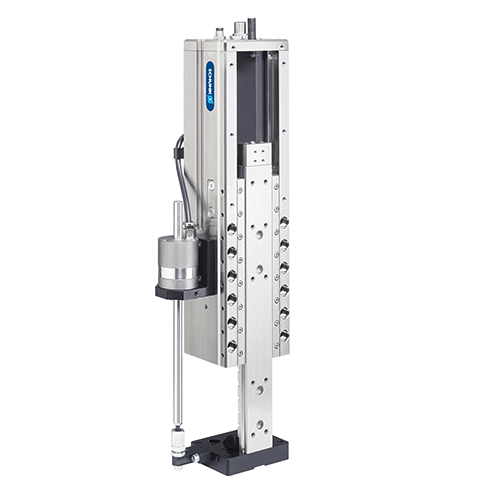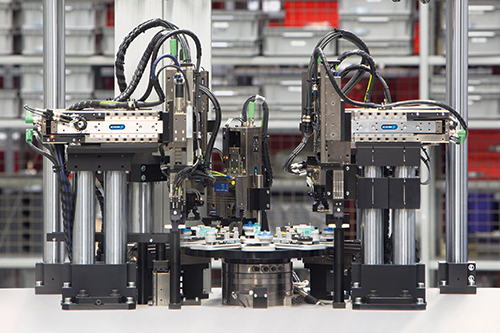
SCHUNK Defines New Benchmark in Assembly Automation
For the first time, complete handling systems can be assembled based on 24V from grippers, rotary gripping units and linear modules
24V revolution
in assembly automation
With its 24V modular system, SCHUNK has defined a new benchmark in assembly automation. For the first time, complete handling systems can be assembled based on 24V from grippers, rotary gripping units and linear modules.
In the user’s opinion, the technology has a great deal of potential. Above all when more and more providers are bringing components based on 24V onto the market – from feeding technology right up to robots that can be used on the move and safety technology.
Eureka moments
There are always components which trigger eureka moments among designers. In handling technology, the SCHUNK ELP linear axis is undoubtedly one such component.

Two to five strokes are enough to complete the programming. During the learning process, the maximum possible speed for the current payload is calculated. The motion profile itself is designed as a ramp, i.e. the unit automatically accelerates and brakes depending on the overall stroke. Impacts and oscillations and uncontrolled driving at maximum speed of the module are therefore excluded.
If the component weight changes during the process, the axis automatically adjusts its movement profile within just a few strokes, without requiring any user intervention.
As the control occurs via digital I/O, the SCHUNK ELP series is compatible with all controllers and can easily replace pneumatic modules. In combination with SCHUNK EGP small parts grippers and SCHUNK EGS rotary gripping modules, a modular system is now available that can be used to implement complete handling solutions based on 24V technology.
Requirements of assembly systems increase
Besides the previously dominating pneumatic networks via which the currently around 70% of all actuators are supplied, and the grids >400V, which are currently circulated for electrically driven actuators and make up around 30%, the 24V technology is on the start line in order to become one of the third largest pillars in the field of assembly automation.
According to the estimation of integrators, systems manufacturers and larger users, it has a wide range of advantages over pneumatics based on modern aspects: a rapidly growing range of varieties in many areas, increasingly sensitive parts, a very hard-fought price war and increasing requirements for energy efficiency and noise emissions play right into the hands of smart technology.
There are hardly any systems today that are still being developed for a single product. Instead, as many variants as possible are to be produced as quickly as possible and must also provide sufficient scope for future design and range modifications.
Accordingly, assembly systems must be set up flexibly today. Pneumatic handling quickly reaches its limits faced with such requirements, particularly if the systems are to also work as noiselessly as possible and technical specifications can since retrieve maximum sound levels close to 60 dB.
Despite the partially enormous progress for pneumatic networks and components, such as valve islands with intelligent pneumatics, micro valves that can be integrated into actuators or moderate purchase prices, this will not fully compensate for the strengths of 24V technology in the long term, meaning a redistribution of the market away from pneumatics right up to 24V technology is foreseeable.
SCHUNK has therefore consciously devoted itself besides the components that have proven themselves for years, such as the MGP-plus small components gripper, to modern 24V modules like the SCHUNK EGP, in order to proactively face the transformation. With the 24V SCHUNK PGN-plus-E universal gripper, the 24V counterpart to the megaseller, the PGN-plus-P, it was even possible to achieve complete maintenance freedom.


Highly dynamic and nevertheless protective
Taking the example of the SCHUNK ELP, it becomes clear how great the advantage over the pneumatic world is: even if users have to invest around double as much as for pneumatic axes, the wear-free module pays for itself in the medium and long term.
For 40 million cycles total output and a maintenance interval of 5 million cycles, for pneumatic axes the costs for wear parts, working time and production downtimes alone add up to a value that far exceeds the total costs of the ELP axes.
For an assembly system with 17 linear modules, in a life cycle of 40 million cycles, this results in a saving of around €12,000 not including the saving for the ongoing operating costs like compressed air.
The costs are amortized after just 20 million cycles. So at the latest from this time, the 24V modules start earning money.
Added to this come design benefits: often enough, throttles are opened far for pneumatic modules in practice, in order to save cycle time and to get the last reserves out of systems.
As a consequence, the wear on the shock absorbers increases rapidly, and so too do the costs. Bigger companies are meanwhile planning fixed maintenance intervals in which all shock absorbers are replaced and re-calibrated regardless of their individual condition.
This is a way of counteracting unplanned system downtimes.
Nevertheless there are still unpleasant side effects in some areas: again and again the massive vibrations in the periphery of pneumatic linear modules also cause other components for instance camera systems to suffer too. The collateral damage in some areas is partly substantial.

This is precisely where the SCHUNK ELP comes in: it allows dynamic movements and nevertheless runs harmoniously and in so doing protects the peripherals in the end positions.
Since the compact unit does not require hydraulic shock absorbers, commissioning and maintenance work is virtually eliminated. What’s more, there is no need to worry about potential damage to your system or long downtimes due to defective shock absorbers.
Furthermore, the system construction can be significantly streamlined because valve blocks, hose systems, maintenance units and pressure boosters are no longer required. Energy chains shrink to half their original scope because only two 24V circuits must be set up for the sensor systems/logics or for the actuators. The fact that the electrical axis is around 20 dB quieter than its pneumatic predecessor is a very pleasant side effect.
In order to simplify the setup of 24V systems, the ultra-compact linear modules are also available upon request with electrically activated holding brake. In the event of a power failure, the brake reliably maintains the position of the linear module and prevents any unintended fall-off of vertically arranged axes into the working area.
This is comparable with pneumatic module rod locks, which help prevent any damage to people, parts and system components. The holding brake allows the STO (Safe Torque Off) safety function to be executed.
The linear module can also be stopped at full speed. The durable brake is particularly suitable for systems that are switched on and off frequently. It can be retrofitted to existing systems at any time.
Great interest in swift program setup
Even if the selection of handling components with 24V technology is still quite limited, the potential the technology has to offer can be imagined.
Systems manufacturers and big users are meanwhile signaling great interest in a fast expansion of the 24V program and use the modules like the ELP linear axis or the EGP parallel gripper specifically to reduce vibrations, as actuators or as assembly systems in small systems and robot cells without compressed air supply. At the latest when the companies active in handling technology provide components on 24V basis in the most important sizes from feeding technology right up to robots and safety technology that can be implemented on the move, the topic will continue to rapidly gain in importance, according to the estimations of a renowned systems engineer.
Ideally, it should be possible to conveniently integrate all components from a central control system. In addition, autonomous functions can minimize the commissioning effort.
The best example here too is the SCHUNK ELP with its auto-learn function: as soon as the system has been wired, the mechanic can commission the handling system before the system is programmed.
Faced with the mostly challenging temporal specifications for some projects, this can also become an important aspect.
Please Contact:
SCHUNK GmbH & Co. KG
Jakob Khoury, Dipl.-Ing. (BA)
Head of Product Marketing
Tel. +49-7133-103-2667
Fax +49-7133-103-942667
[email protected]
schunk.com
Sonja Aufrecht
Diplom-Betriebswirtin (BA), Journalist (FJS)
Head of Corporate Communication and PR
Tel. +49-7133-103-2970
Fax +49-7133-103-2688
[email protected]
schunk.com
